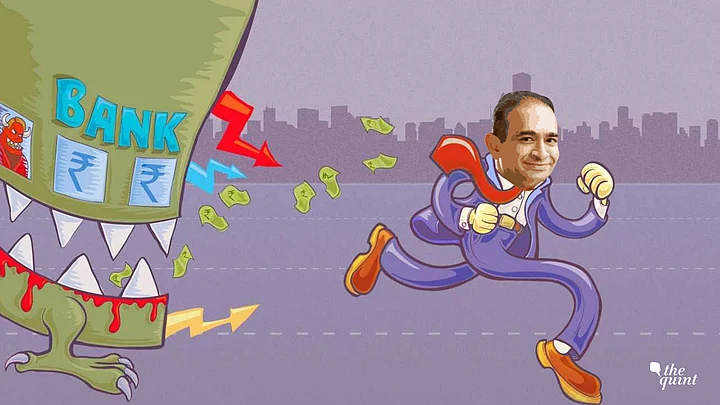“Nirav Modi, Nirav Modi, where have you been?” is a question that the bankers at the Punjab National Bank (PNB) are possibly asking themselves these days.
Media reports suggest that Nirav Modi is in New York, and has no plans of coming back to India. His operational fraud is expected to cost PNB Rs 12,646 crore. PNB is the second largest public sector bank in the country and as of 31 December 2017, had accumulated bad loans of Rs 57,519 crore. A bad loan is a loan which hasn’t been repaid for a period of 90 days or more.
The one good thing that has happened since Nirav Modi’s fraud came to light is the relentless focus of the mainstream media on the operations of India’s government-owned public sector banks.
Nirav Modi Case Points to Bigger Malaise
The total bad loans of the public sector banks as of 31 December 2017 stands at Rs 7,77,280 crore. This forms 86.4 percent of the total bad loans of scheduled commercial banks (i.e. public sector banks + private sector banks + foreign banks). This basically means that the total bad loans of scheduled commercial banks as of 31 December 2017 would be around Rs 9,00,000 crore.
Too busy to read the whole story? Listen to it instead.
Hence, Nirav Modi’s fraud of Rs 12,646 crore is just a drop in this ocean of bad loans. But his fraud has put a face to the sad state of affairs that prevails at public sector banks and has thus, generated interest from the mainstream media and the common public.
Before Nirav Modi came long, the bad loans of public sector banks was just an issue which with the business press was concerned about. Now even the TV channels in different languages are discussing the issue.
Nevertheless, the fundamental issue at the heart of the bad loans of India’s public sector banks continues to remain unaddressed. Who is responsible for this mess and what should be done about it?
Who is Responsible for Our Bad Loans?
The government released some interesting data earlier this month in an answer to a question raised in the Lok Sabha. As per data from the Reserve Bank of India (RBI), the total bad loans from the “industry-large” category of loans, as of 31 December 2017, stood at Rs 5,27,876 crore. This was for scheduled commercial banks as a whole. The RBI defines a large borrower as a borrower with whom the bank has an exposure of Rs 5 crore or more.
Such borrowers are essentially responsible for a bulk of the bad loans of the banks in India. They are responsible for around 59 percent of the bad loans (Rs 5,27,876 crore expressed as a percentage of Rs 9,00,000 crore) of scheduled commercial banks.
Bank loans to large industrial borrowers formed 59 percent of the bad loans, even though the total lending by banks to such borrowers formed only around 30 percent of the total loans given by banks.
Public sector banks accounted for Rs 4,64,253 crore or 88 percent of bad loans in this.
In fact, the much-criticised public sector banks do a pretty decent job of lending to the retail sector. Take a look at the table below, which basically compares the proportion of retail loans which turn bad as compared to loans to corporates which turn bad, for a few public sector banks.
Corporate Bad Loans Against Retail Bad Loans
The above table clearly shows that corporate bad loans are much higher than retail bad loans. The question is why? The answer perhaps lies in what economists call ‘regulatory capture’. As Noble Prize winning French economist Jean Tirole writes in his book Economics for the Common Good:
The state often fails. There are many reasons for these failures. Regulatory capture is one of them. We are well aware of the friendships and mutual support that create complicity between a public body and those who are supposed to be regulating it.
Of Cronies and Capitalism
How does one interpret this in the Indian case? While it would be unfair to suggest that the RBI, which regulates banks in India, is pally with corporates, it would be totally fair to say that Indian politicians are pally with Indian corporates. This is where the problem for public sector banks in India lies.
While giving out retail loans, the managers running public sector banks can make the correct lending decisions, but the same cannot be said when they carry out corporate lending, given the political pressure that prevails on many occasions.
In this scenario, it is worth asking whether all the 21 public sector banks in India should actually carry out corporate lending and put public deposits at risk, over and over again? This is a discussion that we should be having as a nation right now, and the mainstream media should facilitate it.
(Vivek Kaul is the author of ‘India’s Big Government—The Intrusive State and How It is Hurting Us’. This is an opinion piece and the views expressed above are the author’s own. The Quint neither endorses nor is responsible for them.)
(The Quint has given up the use of plastic plates and spoons in its cafeteria. This Earth Hour, what will you #GiveUp to save your planet? Use the hashtag #GiveUp and tag @TheQuint to tell us.)
(At The Quint, we question everything. Play an active role in shaping our journalism by becoming a member today.)
